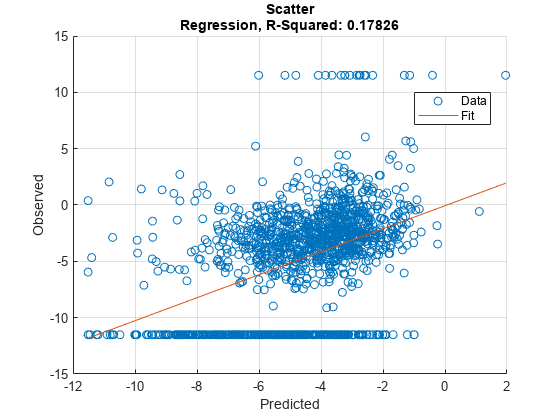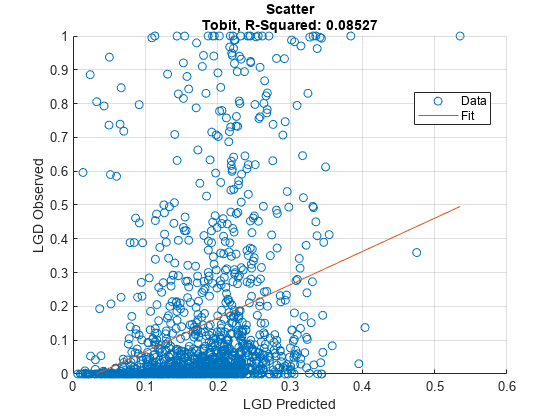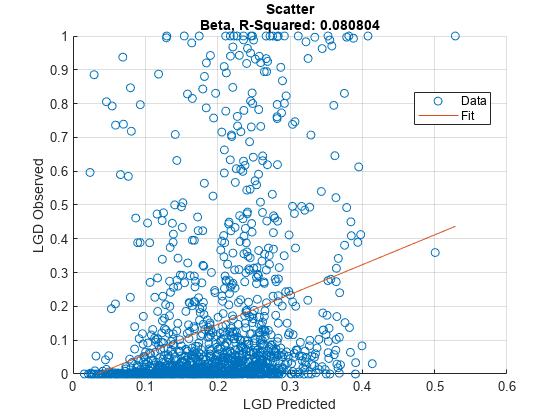modelCalibration
Compute R-square, RMSE, correlation, and sample mean error of predicted and observed LGDs
Since R2023a
Syntax
Description
CalMeasure = modelCalibration(lgdModel,data)modelCalibration supports comparison against a reference
model and also supports different correlation types. By default,
modelCalibration computes the metrics in the LGD scale. You
can use the ModelLevel name-value pair argument to compute
metrics using the underlying model's transformed scale.
[
specifies options using one or more name-value pair arguments in addition to the
input arguments in the previous syntax.CalMeasure,CalData] = modelCalibration(___,Name,Value)
Examples
This example shows how to use fitLGDModel to fit data with a Regression model and then use modelCalibration to compute the R-Square, RMSE, correlation, and sample mean error of predicted and observed LGDs.
Load Data
Load the loss given default data.
load LGDData.mat
head(data) LTV Age Type LGD
_______ _______ ___________ _________
0.89101 0.39716 residential 0.032659
0.70176 2.0939 residential 0.43564
0.72078 2.7948 residential 0.0064766
0.37013 1.237 residential 0.007947
0.36492 2.5818 residential 0
0.796 1.5957 residential 0.14572
0.60203 1.1599 residential 0.025688
0.92005 0.50253 investment 0.063182
Partition Data
Separate the data into training and test partitions.
rng('default'); % for reproducibility NumObs = height(data); c = cvpartition(NumObs,'HoldOut',0.4); TrainingInd = training(c); TestInd = test(c);
Create Regression LGD Model
Use fitLGDModel to create a Regression model using training data.
lgdModel = fitLGDModel(data(TrainingInd,:),'regression');
disp(lgdModel) Regression with properties:
ResponseTransform: "logit"
BoundaryTolerance: 1.0000e-05
ModelID: "Regression"
Description: ""
UnderlyingModel: [1×1 classreg.regr.CompactLinearModel]
PredictorVars: ["LTV" "Age" "Type"]
ResponseVar: "LGD"
WeightsVar: ""
Display the underlying model.
lgdModel.UnderlyingModel
ans =
Compact linear regression model:
LGD_logit ~ 1 + LTV + Age + Type
Estimated Coefficients:
Estimate SE tStat pValue
________ ________ _______ __________
(Intercept) -4.7549 0.36041 -13.193 3.0997e-38
LTV 2.8565 0.41777 6.8377 1.0531e-11
Age -1.5397 0.085716 -17.963 3.3172e-67
Type_investment 1.4358 0.2475 5.8012 7.587e-09
Number of observations: 2093, Error degrees of freedom: 2089
Root Mean Squared Error: 4.24
R-squared: 0.206, Adjusted R-Squared: 0.205
F-statistic vs. constant model: 181, p-value = 2.42e-104
Compute R-Square, RMSE, Correlation, and Sample Mean Error of Predicted and Observed LGDs
Use modelCalibration to compute the RSquared, RMSE, Correlation, and SampleMeanError of the predicted and observed LGDs for the test data set.
[CalMeasure,CalData] = modelCalibration(lgdModel,data(TestInd,:))
CalMeasure=1×4 table
RSquared RMSE Correlation SampleMeanError
________ _______ ___________ _______________
Regression 0.070867 0.25988 0.26621 0.10759
CalData=1394×4 table
Observed Predicted_Regression Residuals_Regression Weights
_________ ____________________ ____________________ _______
0.0064766 0.00091169 0.0055649 1
0.007947 0.0036758 0.0042713 1
0.063182 0.18774 -0.12456 1
0 0.0010877 -0.0010877 1
0.10904 0.011213 0.097823 1
0 0.041992 -0.041992 1
0.89463 0.052947 0.84168 1
0 3.7188e-06 -3.7188e-06 1
0.072437 0.0090124 0.063425 1
0.036006 0.023928 0.012078 1
0 0.0034833 -0.0034833 1
0.39549 0.0065253 0.38896 1
0.057675 0.071956 -0.014281 1
0.014439 0.0061499 0.008289 1
0 0.0012183 -0.0012183 1
0 0.0019828 -0.0019828 1
⋮
Generate a scatter plot of predicted and observed LGDs using modelCalibrationPlot.
modelCalibrationPlot(lgdModel,data(TestInd,:),ModelLevel="underlying")
This example shows how to use fitLGDModel to fit data with a Tobit model and then use modelCalibration to compute R-Square, RMSE, correlation, and sample mean error of predicted and observed LGDs.
Load Data
Load the loss given default data.
load LGDData.mat
head(data) LTV Age Type LGD
_______ _______ ___________ _________
0.89101 0.39716 residential 0.032659
0.70176 2.0939 residential 0.43564
0.72078 2.7948 residential 0.0064766
0.37013 1.237 residential 0.007947
0.36492 2.5818 residential 0
0.796 1.5957 residential 0.14572
0.60203 1.1599 residential 0.025688
0.92005 0.50253 investment 0.063182
Partition Data
Separate the data into training and test partitions.
rng('default'); % for reproducibility NumObs = height(data); c = cvpartition(NumObs,'HoldOut',0.4); TrainingInd = training(c); TestInd = test(c);
Create Tobit LGD Model
Use fitLGDModel to create a Tobit model using training data.
lgdModel = fitLGDModel(data(TrainingInd,:),'tobit');
disp(lgdModel) Tobit with properties:
CensoringSide: "both"
LeftLimit: 0
RightLimit: 1
Weights: [0×1 double]
ModelID: "Tobit"
Description: ""
UnderlyingModel: [1×1 risk.internal.credit.TobitModel]
PredictorVars: ["LTV" "Age" "Type"]
ResponseVar: "LGD"
WeightsVar: ""
Display the underlying model.
disp(lgdModel.UnderlyingModel)
Tobit regression model:
LGD = max(0,min(Y*,1))
Y* ~ 1 + LTV + Age + Type
Estimated coefficients:
Estimate SE tStat pValue
_________ _________ _______ __________
(Intercept) 0.058257 0.027279 2.1356 0.03283
LTV 0.20126 0.03136 6.4177 1.7064e-10
Age -0.095407 0.0072633 -13.135 0
Type_investment 0.10208 0.018077 5.6471 1.8542e-08
(Sigma) 0.29288 0.0057084 51.306 0
Number of observations: 2093
Number of left-censored observations: 547
Number of uncensored observations: 1521
Number of right-censored observations: 25
Log-likelihood: -698.383
Compute R-Square, RMSE, Correlation, and Sample Mean Error of Predicted and Observed LGDs
Use modelCalibration to compute RSquared, RMSE, Correlation, and SampleMeanError of predicted and observed LGDs for the test data set.
[CalMeasure,CalData] = modelCalibration(lgdModel,data(TestInd,:),CorrelationType="kendall")CalMeasure=1×4 table
RSquared RMSE Correlation SampleMeanError
________ _______ ___________ _______________
Tobit 0.08527 0.23712 0.29964 -0.034412
CalData=1394×4 table
Observed Predicted_Tobit Residuals_Tobit Weights
_________ _______________ _______________ _______
0.0064766 0.087889 -0.081412 1
0.007947 0.12432 -0.11638 1
0.063182 0.32043 -0.25724 1
0 0.093354 -0.093354 1
0.10904 0.16718 -0.058144 1
0 0.22382 -0.22382 1
0.89463 0.23695 0.65768 1
0 0.010234 -0.010234 1
0.072437 0.1592 -0.086761 1
0.036006 0.19893 -0.16292 1
0 0.12764 -0.12764 1
0.39549 0.14568 0.2498 1
0.057675 0.26181 -0.20413 1
0.014439 0.14483 -0.13039 1
0 0.094123 -0.094123 1
0 0.10944 -0.10944 1
⋮
Generate a scatter plot of the predicted and observed LGDs using modelCalibrationPlot.
modelCalibrationPlot(lgdModel,data(TestInd,:))

This example shows how to use fitLGDModel to fit data with a Beta model and then use modelCalibration to compute R-Square, RMSE, correlation, and sample mean error of predicted and observed LGDs.
Load Data
Load the loss given default data.
load LGDData.mat
head(data) LTV Age Type LGD
_______ _______ ___________ _________
0.89101 0.39716 residential 0.032659
0.70176 2.0939 residential 0.43564
0.72078 2.7948 residential 0.0064766
0.37013 1.237 residential 0.007947
0.36492 2.5818 residential 0
0.796 1.5957 residential 0.14572
0.60203 1.1599 residential 0.025688
0.92005 0.50253 investment 0.063182
Partition Data
Separate the data into training and test partitions.
rng('default'); % for reproducibility NumObs = height(data); c = cvpartition(NumObs,'HoldOut',0.4); TrainingInd = training(c); TestInd = test(c);
Create Beta LGD Model
Use fitLGDModel to create a Beta model using training data.
lgdModel = fitLGDModel(data(TrainingInd,:),'Beta');
disp(lgdModel) Beta with properties:
BoundaryTolerance: 1.0000e-05
ModelID: "Beta"
Description: ""
UnderlyingModel: [1×1 risk.internal.credit.BetaModel]
PredictorVars: ["LTV" "Age" "Type"]
ResponseVar: "LGD"
WeightsVar: ""
Display the underlying model.
disp(lgdModel.UnderlyingModel)
Beta regression model:
logit(LGD) ~ 1_mu + LTV_mu + Age_mu + Type_mu
log(LGD) ~ 1_phi + LTV_phi + Age_phi + Type_phi
Estimated coefficients:
Estimate SE tStat pValue
________ ________ _______ __________
(Intercept)_mu -1.3772 0.13201 -10.433 0
LTV_mu 0.6027 0.15087 3.9948 6.6993e-05
Age_mu -0.47464 0.040264 -11.788 0
Type_investment_mu 0.45372 0.085143 5.3289 1.0941e-07
(Intercept)_phi -0.16336 0.12591 -1.2974 0.19462
LTV_phi 0.055886 0.14719 0.37969 0.70421
Age_phi 0.22887 0.040335 5.6743 1.586e-08
Type_investment_phi -0.14102 0.078155 -1.8044 0.071313
Number of observations: 2093
Log-likelihood: -5291.04
Compute R-Square, RMSE, Correlation, and Sample Mean Error of Predicted and Observed LGDs
Use modelCalibration to compute RSquared, RMSE, Correlation, and SampleMeanError of predicted and observed LGDs for the test data set.
[CalMeasure,CalData] = modelCalibration(lgdModel,data(TestInd,:),CorrelationType="kendall")CalMeasure=1×4 table
RSquared RMSE Correlation SampleMeanError
________ _______ ___________ _______________
Beta 0.080804 0.24112 0.29448 -0.052396
CalData=1394×4 table
Observed Predicted_Beta Residuals_Beta Weights
_________ ______________ ______________ _______
0.0064766 0.093695 -0.087218 1
0.007947 0.14915 -0.1412 1
0.063182 0.35263 -0.28945 1
0 0.096434 -0.096434 1
0.10904 0.18858 -0.079542 1
0 0.2595 -0.2595 1
0.89463 0.26767 0.62696 1
0 0.021315 -0.021315 1
0.072437 0.17736 -0.10492 1
0.036006 0.22556 -0.18955 1
0 0.13369 -0.13369 1
0.39549 0.16768 0.2278 1
0.057675 0.29159 -0.23392 1
0.014439 0.1617 -0.14726 1
0 0.10506 -0.10506 1
0 0.1161 -0.1161 1
⋮
Generate a scatter plot of the predicted and observed LGDs using modelCalibrationPlot.
modelCalibrationPlot(lgdModel,data(TestInd,:))

Input Arguments
Loss given default model, specified as a previously created Regression,
Tobit, or Beta object using
fitLGDModel.
Data Types: object
Data, specified as a
NumRows-by-NumCols table with
predictor and response values. The variable names and data types must be
consistent with the underlying model.
Data Types: table
Name-Value Arguments
Specify optional pairs of arguments as
Name1=Value1,...,NameN=ValueN, where Name is
the argument name and Value is the corresponding value.
Name-value arguments must appear after other arguments, but the order of the
pairs does not matter.
Example: [CalMeasure,CalData] =
modelCalibration(lgdModel,data(TestInd,:),DataID='Testing',CorrelationType='spearman')
Correlation type, specified as CorrelationType and
a character vector or string.
Data Types: char | string
Data set identifier, specified as DataID and a
character vector or string. The DataID is included in
the output for reporting purposes.
Data Types: char | string
Model level, specified as ModelLevel and a
character vector or string.
'top'— The accuracy metrics are computed in the LGD scale at the top model level.'underlying'— For aRegressionmodel only, the metrics are computed in the underlying model's transformed scale. The metrics are computed on the transformed LGD data.
Data Types: char | string
Identifier for the reference model, specified as
ReferenceID and a character vector or string.
'ReferenceID' is used in the
modelCalibration output for reporting
purposes.
Data Types: char | string
Output Arguments
Calibration measure, returned as a table with columns
'RSquared', 'RMSE',
'Correlation', and
'SampleMeanError'. CalMeasure has
one row if only the lgdModel accuracy is measured and
it has two rows if reference model information is given. The row names of
CalMeasure report the model ID and data ID (if
provided).
Calibration data, returned as a table with observed LGD values, predicted
LGD values, and residuals (observed minus predicted). Additional columns for
predicted and residual values are included for the reference model, if
provided. The ModelID and
ReferenceID labels are appended in the column
names. The last column contains Weights.
More About
Model calibration measures the accuracy of the predicted probability of LGD values using different metrics.
R-squared — To compute the R-squared metric,
modelCalibrationfits a linear regression of the observed LGD values against the predicted LGD valuesThe R-square of this regression is reported. For more information, see Coefficient of Determination (R-Squared).
RMSE — To compute the root mean square error (RMSE),
modelCalibrationuses the following formula where N is the number of observations:Correlation — This is the correlation between the observed and predicted LGD:
For more information and details about the different correlation types, see
corr.Sample mean error — This is the difference between the mean observed LGD and the mean predicted LGD or, equivalently, the mean of the residuals:
If the LGD model object is created by using the
WeightsVarname-value argument, the R-square, RMSE, correlation, and sample mean error of the predicted and observed LGD data are weighted quantities.
References
[1] Baesens, Bart, Daniel Roesch, and Harald Scheule. Credit Risk Analytics: Measurement Techniques, Applications, and Examples in SAS. Wiley, 2016.
[2] Bellini, Tiziano. IFRS 9 and CECL Credit Risk Modelling and Validation: A Practical Guide with Examples Worked in R and SAS. San Diego, CA: Elsevier, 2019.
Version History
Introduced in R2023aThe CalData output supports an additional column for
Weights.
See Also
Tobit | Regression | Beta | modelCalibrationPlot | modelDiscriminationPlot | modelDiscrimination | predict | fitLGDModel
MATLAB Command
You clicked a link that corresponds to this MATLAB command:
Run the command by entering it in the MATLAB Command Window. Web browsers do not support MATLAB commands.
选择网站
选择网站以获取翻译的可用内容,以及查看当地活动和优惠。根据您的位置,我们建议您选择:。
您也可以从以下列表中选择网站:
如何获得最佳网站性能
选择中国网站(中文或英文)以获得最佳网站性能。其他 MathWorks 国家/地区网站并未针对您所在位置的访问进行优化。
美洲
- América Latina (Español)
- Canada (English)
- United States (English)
欧洲
- Belgium (English)
- Denmark (English)
- Deutschland (Deutsch)
- España (Español)
- Finland (English)
- France (Français)
- Ireland (English)
- Italia (Italiano)
- Luxembourg (English)
- Netherlands (English)
- Norway (English)
- Österreich (Deutsch)
- Portugal (English)
- Sweden (English)
- Switzerland
- United Kingdom (English)